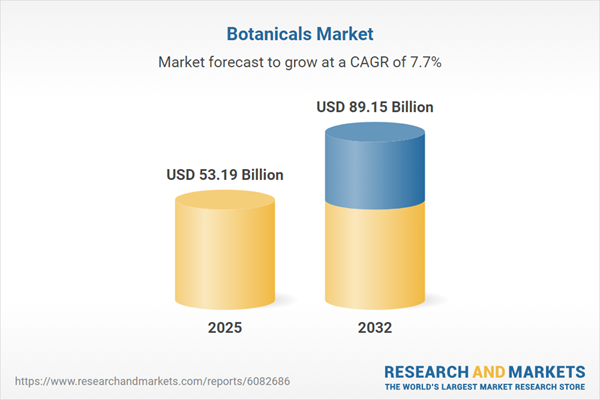Speak directly to the analyst to clarify any post sales queries you may have.
The botanicals market is quickly becoming a focal point for companies aiming to offer cleaner-label, differentiated products, as natural ingredient integration, advanced extraction methods, and transparent supply chains gain priority across industries. Senior leaders are leveraging botanicals to enhance wellness offerings and respond to increasing transparency and sustainability expectations in the global market.
Market Snapshot: Botanicals Market Size and Growth Outlook
The global botanicals market is projected to grow from USD 49.40 billion in 2024 to USD 53.19 billion in 2025, with a robust compound annual growth rate (CAGR) of 7.65% through to 2032, targeting a market size of USD 89.15 billion. Growth momentum is driven by widespread adoption of plant-based ingredients across beauty, nutrition, food and beverage, wellness, and pharmaceutical industries. Industry suppliers are investing in advanced extraction and processing to ensure consistent product quality, while compliance requirements and demand for traceability are increasingly influencing purchasing decisions. Botanicals play a pivotal role in meeting quality, transparency, and regulatory alignment needs, underscoring their growing importance throughout the sector.
Scope & Segmentation of the Botanicals Market
This report presents actionable insights and a comprehensive segmentation analysis to enable executive teams to inform strategic planning and capitalize on market opportunities across the botanicals value chain.
- Product Type: Essential oils, herbal extracts, oleoresins, and resins each contribute unique properties to modern product development, serving both traditional and emerging applications.
- Application: Botanicals support cosmetics and personal care, dietary supplements, food and beverage—including both functional beverages and conventional foods—and pharmaceuticals, reflecting broad commercial acceptance and innovation capacity.
- Physical Form: Capsules, concentrated and emulsion liquids, powders, and tablets offer manufacturers flexibility in formulation and scalability across target markets.
- Distribution Channel: Online retail via brand websites and third-party e-commerce, pharmacies and drug stores, specialty stores, and supermarkets or hypermarkets facilitate efficient access for varied buyer groups.
- Botanical Source: A wide range of sources—flowers, fruits, leaves, roots, and seeds—enables product diversity and responsiveness to consumer trends.
- Extraction Method: Diverse extraction options, including cold pressing, solvent extraction, steam distillation, and supercritical fluid extraction, support precision in purity and functional profile development.
- Regions: The market spans the Americas (with North America and Latin America), Europe, Middle East and Africa, and Asia-Pacific, with strategy refinement needed to match local market maturity and regulatory context.
- Key Companies Analyzed: Givaudan SA, International Flavors & Fragrances Inc., Symrise AG, Chr. Hansen Holding A/S, Döhler GmbH, Archer Daniels Midland Company, Kerry Group plc, Ingredion Incorporated, Koninklijke DSM N.V., and Kalsec Inc. are featured for their significant roles and innovation leadership.
Key Takeaways for Senior Decision-Makers
- Botanical ingredients are incorporated into advanced formulations, relying on improved extraction and purification to deliver targeted functional and purity characteristics for complex product lines.
- End-to-end supply chain traceability and relevant certifications are essential to keep pace with evolving regulations and secure market access, especially in established economies.
- Sustainability initiatives focused on regenerative agriculture and efficient resource management are now factors in supplier selection and attract responsible buyers and investment.
- Cross-sector collaboration among agriculture, technology, and consumer goods expertise is fostering innovation, with new developments routinely arising in the bioactives segment.
- Digital platforms and enhanced traceability tools improve distribution visibility, streamline operations, and reinforce channels for reaching final consumers directly.
- Differences in regional market development call for adaptable market entry approaches, tailor-made to local regulations and the growth lifecycle of each area.
Tariff Impact: Navigating U.S. Trade Measures
Recent U.S. tariffs in 2025 have posed additional sourcing and cost challenges for imported botanicals. Companies have adapted by diversifying supplier networks, prioritizing regional sourcing, and pursuing long-term supply agreements to manage risk exposure. Some emerging suppliers are gaining regional share due to favorable tariff conditions, while internal process optimization is helping organizations offset a portion of increased costs. In this evolving trade environment, robust risk management and responsive sourcing frameworks are essential for continued market access and stability.
Methodology & Data Sources
This research integrates primary data from executive interviews and direct site assessments, combined with secondary research from industry publications, scientific reports, and regulatory reviews. Validation through expert consultation and triangulation ensures actionable and trustworthy recommendations for leadership teams.
Why This Report Matters
- Enables industry executives to seize strategic market opportunities and address regulatory or geopolitical risks unique to the botanicals sector.
- Guides data-driven technology investments, enhances traceability initiatives, and supports sustainable sourcing strategies to build long-term resilience.
- Facilitates R&D planning and cross-border partnership development through timely analysis of market trends and drivers.
Conclusion
This thorough report empowers senior leaders to drive innovation, navigate regulatory complexity, and optimize sourcing and market positioning within the growing botanicals sector.
Table of Contents
3. Executive Summary
4. Market Overview
7. Cumulative Impact of Artificial Intelligence 2025
Companies Mentioned
The companies profiled in this Botanicals market report include:- Givaudan SA
- International Flavors & Fragrances Inc.
- Symrise AG
- Chr. Hansen Holding A/S
- Döhler GmbH
- Archer Daniels Midland Company
- Kerry Group plc
- Ingredion Incorporated
- Koninklijke DSM N.V.
- Kalsec Inc.
Table Information
| Report Attribute | Details |
|---|---|
| No. of Pages | 194 |
| Published | October 2025 |
| Forecast Period | 2025 - 2032 |
| Estimated Market Value ( USD | $ 53.19 Billion |
| Forecasted Market Value ( USD | $ 89.15 Billion |
| Compound Annual Growth Rate | 7.6% |
| Regions Covered | Global |
| No. of Companies Mentioned | 11 |









